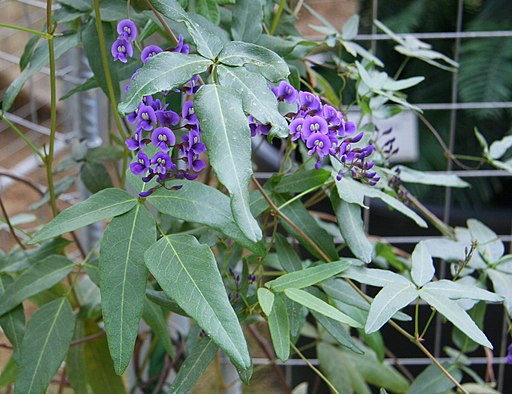Classification System: APG IV
Superregnum: Eukaryota
Regnum: Plantae
Cladus: Angiosperms
Cladus: Eudicots
Cladus: Core eudicots
Cladus: Rosids
Cladus: Eurosids I
Ordo: Fabales
Familia: Fabaceae
Subfamilia: Faboideae
Tribus: Phaseoleae
Subtribus: Kennediinae
Genus: Hardenbergia
Species: Hardenbergia comptoniana
Name
Hardenbergia comptoniana (Andrews) Benth. (1837)
Synonyms
Caulinia comptoniana (Andrews) F.Muell.
Glycine comptoniana Andrews
Hardenbergia digitata Lindl.
Hardenbergia huegelii Benth.
Hardenbergia lindleyi Meisn.
Hardenbergia lindleyi var. digitata (Lindl.) Meisn.
Hardenbergia lindleyi var. trifoliata Meisn.
Hardenbergia macrophylla (Lindl.) Benth.
Hardenbergia makoyana Lem.
Kennedia comptoniana (Andrews) Link
Kennedia comptoniana var. quinquefolia Graham
Kennedia macrophylla Lindl.
Kennedia makoyana (Lem.) Daveau
Notes
Hardenbergia × makoyana Lem. represent the hybrid between H. comptoniana (Andrews) Benth. and H. macrophylla (Lindl.) Benth., if these was to be accepted as distinct.
Homonyms
Kennedia macrophylla (Meisn.) Benth. (1864) = Kennedia lateritia F.Muell.
Distribution
Native distribution areas:
Continental: Australasia
Regional: Australia
Western Australia
Introduced into:
India, New South Wales
References: Brummitt, R.K. 2001. TDWG – World Geographical Scheme for Recording Plant Distributions, 2nd Edition
References
Primary references
Bentham, G. in Endlicher, S.L. , Fenzl, E., Bentham, G. & Schott, H.W.. 1837. Enumeratio plantarum quas in Novae Hollandiae ora austro-occidentali ad fluvium Cygnorum et in Sinu Regis Georgii collegit Carous liber baro de Hugel 41.
Additional references
Lepschi, B. & Monro, A. (Project Coordinators) (2014). Australian Plant Census (APC) Council of Heads of Australian Herbaria. http://www.anbg.gov.au/chah/apc/index.html.
Kumar, S. & Sane, P.V. (2003). Legumes of South Asia. A Checklist: 1-536. Royal Botanic Gardens, Kew.
Links
Govaerts, R. et al. 2021. Hardenbergia comptoniana in Kew Science Plants of the World online. The Board of Trustees of the Royal Botanic Gardens, Kew. Published online. Accessed: 2021 May 17. Reference page.
International Plant Names Index. 2021. Hardenbergia comptoniana. Published online. Accessed: May 17 2021.
Tropicos.org 2021. Hardenbergia comptoniana. Missouri Botanical Garden. Published online. Accessed: 17 May 2021.
Hassler, M. 2021. Hardenbergia comptoniana. World Plants: Synonymic Checklists of the Vascular Plants of the World In: Roskovh, Y., Abucay, L., Orrell, T., Nicolson, D., Bailly, N., Kirk, P., Bourgoin, T., DeWalt, R.E., Decock, W., De Wever, A., Nieukerken, E. van, Zarucchi, J. & Penev, L., eds. 2021. Species 2000 & ITIS Catalogue of Life. Published online. Accessed: 2021 May 17. Reference page.
Hassler, M. 2021. World Plants. Synonymic Checklist and Distribution of the World Flora. . Hardenbergia comptoniana. Accessed: 17 May 2021.
USDA, ARS, Germplasm Resources Information Network. Hardenbergia comptoniana in the Germplasm Resources Information Network (GRIN), U.S. Department of Agriculture Agricultural Research Service. Accessed: 07-Oct-06.
Australian Plant Name Index (APNI) Hardenbergia comptoniana Integrated Botanical Information System (IBIS). Australian National Botanic Gardens & Australian National Herbarium. Accessed: 2012 Feb 10.
Vernacular names
English: Native Lilac, Native Wisteria, Wild Sarsaparille, Wild Wisteria Climber
Hardenbergia comptoniana is a species of flowering plant in the pea family, Fabaceae, native to Western Australia.[1] A twining vine, it produces purple flowers in the Southern Hemisphere spring. It is found on sand dunes and sand plains, and in open forest, on sand- or clay-based soils. It is readily cultivated in the garden, where it does best in a part-shaded position.
Description
It is a vigorous twining vine with characteristically narrow trifoliate leaves, which distinguish it readily from its closest relative Hardenbergia violacea which has entire leaves.[3]
The pea-shaped flowers appear from August to November (Southern Hemisphere late winter to spring) and can range in colour from mauve, to purple to dark blue, with pink and white forms also known. The two eye spots on the standard are white, in contrast to the light green-yellow spots on H. violacea. The flowers are arranged in drooping racemes. The flowers are followed by the development of the smooth grey-brown cylindrical seed pods. They are around 3.5 centimetres (1.4 in) long.[3] The seed pods make an audible 'pop' when they release the seeds.[4]
Taxonomy
Henry Cranke Andrews described this species as Glycine comptoniana, naming it for the Lady Northampton as it was in her garden that a specimen had flowered;[5] her surname was Compton.[3] It was given its current name in 1837 by George Bentham.[6]
Common names include native lilac, wild sarsaparilla and wild wisteria climber.[3]
Distribution and habitat
Hardenbergia comptoniana is found on the coastal plain from Geraldton to Albany in Western Australia, on sand dunes, limestone areas and sandplains.[7] It also grows in forested areas further inland on both sand- and clay-based soils.[4]
Use in horticulture
Growing on a trellis, Perth, Western Australia
H. comptoniana was brought into cultivation in England in 1810 by the 1st Marchioness of Northampton.[3]
The plant is fairly vigorous and can cover a 3 by 3 metres (9.8 by 9.8 ft) area in two years, smothering smaller plants it is allowed to grow over. Partly shaded positions in the garden are most suitable.[3] It is capable of growing high into surrounding trees or can cover fences or trellises rapidly, once established.
Seed propagation is straightforward,[4] while cuttings can also be struck successfully.[3]
References
Wikimedia Commons has media related to Hardenbergia comptoniana.
"Hardenbergia comptoniana". Australian Plant Name Index (APNI), IBIS database. Centre for Plant Biodiversity Research, Australian Government, Canberra. Retrieved 9 January 2015.
"Hardenbergia comptoniana (Andrews) Benth." Plants of the World Online, Kew Science. Accessed 11 May 2022.
Elliot, Rodger W.; Jones, David L.; Blake, Trevor (1990). Encyclopaedia of Australian Plants Suitable for Cultivation: Vol. 5. Port Melbourne: Lothian Press. p. 251. ISBN 978-0-85091-285-2.
Western Australian Herbarium. "Plant of the Month — August 2011: Hardenbergia comptoniana (Andrews) Benth. — Native Wisteria". FloraBase. Department of Biodiversity, Conservation and Attractions. Retrieved 11 January 2018.
Andrews, Henry C. (1810). The Botanists Repository for New and Rare Plants. Vol. 9. T. Bensley. p. 62.
Bentham, George (1837). Enumeratio plantarum quas in Novae Hollandiae ora austro-occidentali ad fluvium Cygnorum et in Sinu Regis Georgii collegit Carolus liber baro de Hügel. Vienna: F. Beck. p. 41.
"Hardenbergia comptoniana". FloraBase. Western Australian Government Department of Biodiversity, Conservation and Attractions.
Retrieved from "http://en.wikipedia.org/"
All text is available under the terms of the GNU Free Documentation License


